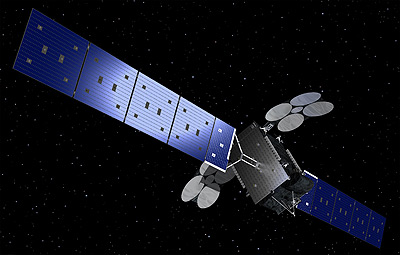Thank you very much for visiting Gunter's Space Page. I hope that this site is useful and informative for you.
If you appreciate the information provided on this site, please consider supporting my work by making a simple and secure donation via PayPal. Please help to run the website and keep everything free of charge. Thank you very much.
OSC → Orbital ATK → Northrop Grumman Innovation Systems (NGIS): Star-3 → GeoStar-3

Al Yah 3 [Orbital]
The GEOStar-3 satellite platform represents an evolutionary growth of Orbital's GEOStar-2 platform, providing an incremental expansion of the flight-proven GEOStar-2 product line.
EPS enhancements include an increase in battery capacity and in solar array power, enabling GEOStar-3 to provide up to 8,000 watts of power to the payload at end-of-life. The larger solar arrays and additional battery capacity retain the 100 percent successful flight heritage 36 volt regulated power bus. The GEOStar-3 Bus structure’s mass carrying capability and propellant tank accommodation enable optimal use of launch vehicle performance, and can include tandem launch missions that use heritage bi-propellant apogee engines to ensure fast and reliable orbit raising. For heavier missions, a flight proven Electric Propulsion system will replace the heritage ImpEHTs for stationkeeping operations
he GEOStar-3 Bus can accommodate payloads of up to 800 kilograms and 8,000 watts. As many as 72 radiatively cooled TWTAs, or a greater combination of radiatively and conductively cooled TWTAs can easily be accommodated on the platform. The total payload conductive thermal dissipation is scalable up to 4,800 watts. The platform can accommodate a broad range of depoyable reflectors and nadir antenna configurations, enabling compelling payload solutions. The expanded payload envelope of GEOStar-3 also allows customers to consider a larger universe of hosted payload opportunities.
| Satellite | Ordered | Date | Launcher | Weight (kg) | Remarks | ||
|---|---|---|---|---|---|---|---|
| Launch | BOL | ||||||
| Al Yah 3 | 2014 | 25.01.2018 | Ariane-5ECA | 3795 | |||
| ASBM 1 (GX 10A, EPS-R 1) | 2019 | 2024 | Falcon-9 v1.2 (Block 5) | 2000 | |||
| ASBM 2 (GX 10B, EPS-R 2) | 2019 | 2024 | Falcon-9 v1.2 (Block 5) | 2000 | |||
| Galaxy 33 (Galaxy 15R) | 2020 | 08.10.2022 | Falcon-9 v1.2 (Block 5) | 3654 | |||
| Galaxy 34 (Galaxy 12R) | 2020 | 08.10.2022 | Falcon-9 v1.2 (Block 5) | 3695 | |||
| GovSat 1 (SES 16) | 2015 | 31.01.2018 | Falcon-9 v1.2 | 4230 | |||
| HYLAS 4 | 2014 | 05.04.2018 | Ariane-5ECA | 4050 | |||
| MEV 1 | 09.10.2019 | Proton-M Briz-M (Ph.4) | 2326 | ||||
| MEV 2 | 15.08.2020 | Ariane-5ECA+ | 2875 | ||||
| MRV 1 (RSGS) | 2020 | 2024 | Falcon-9 v1.2 (Block 5) | 3000 | |||
| SES 18 | 2020 | 17.03.2023 | Falcon-9 v1.2 (Block 5) | ||||
| SES 19 | 2020 | 17.03.2023 | Falcon-9 v1.2 (Block 5) | ||||
